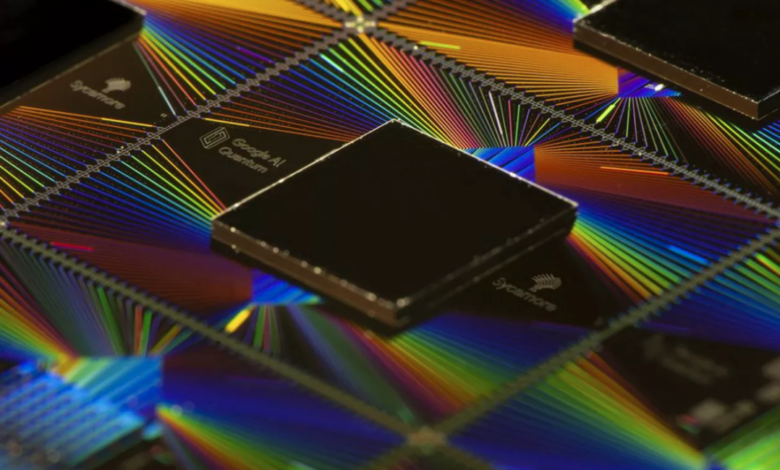
Quantum computing has emerged as one of the most transformative technologies of the 21st century, promising to revolutionize industries by solving problems that are currently intractable for classical computers. Among the various approaches to building quantum computers, photonic qubits—leveraging the quantum properties of photons—offer a unique and promising path to achieving quantum supremacy. This milestone refers to the point at which a quantum computer can perform a calculation that is beyond the reach of even the most powerful classical supercomputers.
In this article, we will explore the principles of photonic qubits, the challenges and innovations associated with them, and the roadmap to achieving quantum supremacy with photonic quantum computing systems.
Understanding Photonic Qubits
Photonic qubits are the fundamental units of quantum information in a photonic quantum computer. Unlike traditional quantum systems that use electrons or atoms, photonic systems leverage photons—particles of light—to represent and process quantum information. Photons are inherently robust against decoherence, making them ideal candidates for quantum computing applications.
Photonic qubits are typically encoded using one or more of the following properties of photons:
- Polarization: The orientation of the photon’s electric field (e.g., horizontal or vertical polarization).
- Time-Bin Encoding: Temporal separation of photons into discrete time slots.
- Path Encoding: The spatial path taken by the photon in an optical network.
These properties allow photons to exist in superposition states and be entangled with other qubits, two key features that form the foundation of quantum computing.
Advantages of Photonic Qubits
Photonic qubits offer several advantages over other quantum systems, making them particularly well-suited for achieving quantum supremacy:
-
Room-Temperature Operation
- Unlike superconducting qubits, which require ultra-low temperatures, photonic qubits can operate at room temperature. This significantly reduces the complexity and cost of building and maintaining a photonic quantum computer.
- Unlike superconducting qubits, which require ultra-low temperatures, photonic qubits can operate at room temperature. This significantly reduces the complexity and cost of building and maintaining a photonic quantum computer.
-
Scalability
- Photonic systems can leverage integrated photonic circuits to perform quantum operations on a large scale. Advances in nanofabrication are enabling the creation of compact, high-density photonic chips, which are essential for building scalable quantum systems.
- Photonic systems can leverage integrated photonic circuits to perform quantum operations on a large scale. Advances in nanofabrication are enabling the creation of compact, high-density photonic chips, which are essential for building scalable quantum systems.
-
Robustness Against Decoherence
- Photons do not interact strongly with their environment, making them less prone to decoherence compared to other qubits. This stability is critical for maintaining quantum coherence over long durations.
- Photons do not interact strongly with their environment, making them less prone to decoherence compared to other qubits. This stability is critical for maintaining quantum coherence over long durations.
-
Compatibility with Fiber-Optic Networks
- Photonic quantum systems can seamlessly integrate with existing fiber-optic communication infrastructure, paving the way for distributed quantum computing and quantum internet applications.
- Photonic quantum systems can seamlessly integrate with existing fiber-optic communication infrastructure, paving the way for distributed quantum computing and quantum internet applications.
Challenges in Achieving Quantum Supremacy
Despite their advantages, achieving quantum supremacy with photonic qubits comes with its own set of challenges:
-
Efficient Single-Photon Sources
- Generating single photons on demand is a technical challenge that requires highly efficient and reliable photon sources. Quantum dots and spontaneous parametric down-conversion (SPDC) are common approaches, but further improvements are needed to enhance efficiency and indistinguishability.
- Generating single photons on demand is a technical challenge that requires highly efficient and reliable photon sources. Quantum dots and spontaneous parametric down-conversion (SPDC) are common approaches, but further improvements are needed to enhance efficiency and indistinguishability.
-
Photon Loss
- Photons can be lost due to imperfect optical components or during transmission through fiber. Reducing photon loss is essential to maintaining the integrity of quantum operations.
- Photons can be lost due to imperfect optical components or during transmission through fiber. Reducing photon loss is essential to maintaining the integrity of quantum operations.
-
Error Correction
- Implementing error correction in photonic systems is complex due to the probabilistic nature of photon detection and manipulation. Advanced error-correcting codes and fault-tolerant architectures are required to address this issue.
- Implementing error correction in photonic systems is complex due to the probabilistic nature of photon detection and manipulation. Advanced error-correcting codes and fault-tolerant architectures are required to address this issue.
-
Scalability
- Building large-scale photonic quantum systems requires the integration of thousands or even millions of components. Ensuring high precision and low loss in these systems is a significant engineering challenge.
- Building large-scale photonic quantum systems requires the integration of thousands or even millions of components. Ensuring high precision and low loss in these systems is a significant engineering challenge.
Innovations Driving Photonic Quantum Computing
Recent innovations are addressing these challenges and bringing photonic quantum computing closer to achieving quantum supremacy:
-
Integrated Photonic Chips
- Advances in integrated photonics are enabling the creation of photonic circuits with high density and functionality. These chips can perform multiple quantum operations within a compact footprint, making them ideal for scalable quantum systems.
- Advances in integrated photonics are enabling the creation of photonic circuits with high density and functionality. These chips can perform multiple quantum operations within a compact footprint, making them ideal for scalable quantum systems.
-
Quantum Memory
- Quantum memory is essential for storing and synchronizing quantum information. Researchers are developing optical quantum memory systems using atomic ensembles and rare-earth-ion-doped crystals, which can interface seamlessly with photonic qubits.
- Quantum memory is essential for storing and synchronizing quantum information. Researchers are developing optical quantum memory systems using atomic ensembles and rare-earth-ion-doped crystals, which can interface seamlessly with photonic qubits.
-
Improved Photon Sources and Detectors
- High-efficiency single-photon sources and detectors are critical for reliable quantum operations. Innovations in quantum dot technology and superconducting nanowire single-photon detectors (SNSPDs) are enhancing the performance of these components.
- High-efficiency single-photon sources and detectors are critical for reliable quantum operations. Innovations in quantum dot technology and superconducting nanowire single-photon detectors (SNSPDs) are enhancing the performance of these components.
-
Machine Learning in Photonic Quantum Design
- Machine learning algorithms are being employed to optimize the design and operation of photonic quantum systems, from improving photon routing to minimizing loss in optical networks.
- Machine learning algorithms are being employed to optimize the design and operation of photonic quantum systems, from improving photon routing to minimizing loss in optical networks.
Steps to Achieving Quantum Supremacy with Photonic Qubits
Achieving quantum supremacy requires a combination of technological advancements and innovative approaches. Here are the key steps:
-
High-Fidelity Quantum Gates
- Implementing high-fidelity quantum gates is essential for performing accurate quantum operations. Linear optical quantum computing (LOQC) uses beam splitters, phase shifters, and other optical components to achieve this goal. Researchers are also exploring hybrid approaches that combine linear optics with nonlinear effects for enhanced performance.
- Implementing high-fidelity quantum gates is essential for performing accurate quantum operations. Linear optical quantum computing (LOQC) uses beam splitters, phase shifters, and other optical components to achieve this goal. Researchers are also exploring hybrid approaches that combine linear optics with nonlinear effects for enhanced performance.
-
Error-Correcting Codes
- Error correction is vital for fault-tolerant quantum computing. Photonic quantum systems are adopting error-correcting codes like surface codes and cluster states to mitigate errors and maintain coherence.
- Error correction is vital for fault-tolerant quantum computing. Photonic quantum systems are adopting error-correcting codes like surface codes and cluster states to mitigate errors and maintain coherence.
-
Large-Scale Integration
- Building scalable systems requires the integration of thousands of photonic components on a single chip. Advances in nanofabrication and 3D integration are critical for achieving this milestone.
- Building scalable systems requires the integration of thousands of photonic components on a single chip. Advances in nanofabrication and 3D integration are critical for achieving this milestone.
-
Benchmarking Against Classical Computers
- Demonstrating quantum supremacy involves solving a computational problem that classical computers cannot efficiently perform. Tasks like Gaussian boson sampling (GBS) and solving certain optimization problems are being explored as benchmarks for photonic quantum computers.
- Demonstrating quantum supremacy involves solving a computational problem that classical computers cannot efficiently perform. Tasks like Gaussian boson sampling (GBS) and solving certain optimization problems are being explored as benchmarks for photonic quantum computers.
-
Building a Quantum Ecosystem
- Achieving quantum supremacy is not just about building powerful hardware. It requires the development of a quantum ecosystem, including software, algorithms, and applications tailored to photonic quantum computing systems.
- Achieving quantum supremacy is not just about building powerful hardware. It requires the development of a quantum ecosystem, including software, algorithms, and applications tailored to photonic quantum computing systems.
Applications Beyond Quantum Supremacy
Once quantum supremacy is achieved, photonic quantum computers will unlock a wide range of applications:
-
Cryptography
- Photonic quantum systems can enable secure communication through quantum key distribution (QKD) and post-quantum cryptography.
- Photonic quantum systems can enable secure communication through quantum key distribution (QKD) and post-quantum cryptography.
-
Optimization Problems
- Industries such as logistics, finance, and energy can benefit from quantum algorithms that optimize resource allocation and decision-making processes.
- Industries such as logistics, finance, and energy can benefit from quantum algorithms that optimize resource allocation and decision-making processes.
-
Drug Discovery
- Simulating molecular interactions with photonic quantum computers can accelerate drug discovery and materials science research.
- Simulating molecular interactions with photonic quantum computers can accelerate drug discovery and materials science research.
-
Artificial Intelligence
- Quantum-enhanced machine learning algorithms can leverage the parallel processing capabilities of photonic systems to accelerate AI tasks like pattern recognition and data analysis.
- Quantum-enhanced machine learning algorithms can leverage the parallel processing capabilities of photonic systems to accelerate AI tasks like pattern recognition and data analysis.
The Future of Photonic Quantum Computing
The journey to quantum supremacy with photonic qubits is both exciting and challenging. As researchers continue to overcome technical barriers, the potential of photonic quantum computers becomes increasingly clear. Their robustness, scalability, and compatibility with existing communication infrastructure position them as a leading contender in the quantum race.
To explore the potential of advancements in this thriving industry, the design and optimization of a photonic quantum computer play a critical role in pushing boundaries and realizing practical implementations. These innovations are shaping the future of computation, enabling breakthroughs that will redefine the limits of what is computationally possible.
Conclusion
Achieving quantum supremacy with photonic qubits represents a major milestone in quantum science and technology. By leveraging the unique properties of photons and overcoming challenges related to scalability, error correction, and photon loss, researchers are unlocking new possibilities in computation, communication, and beyond. The path forward requires continued innovation, investment, and collaboration, but the rewards—from revolutionizing industries to deepening our understanding of the universe—make the effort worthwhile. The era of photonic quantum supremacy is on the horizon, promising a transformative impact on science, technology, and society.




